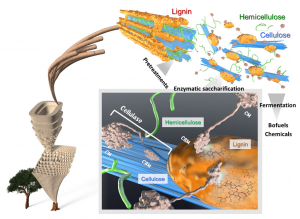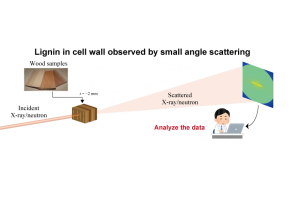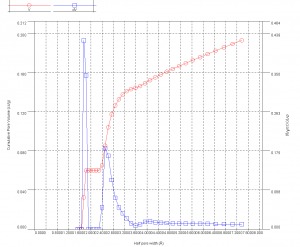2020 Activity Report for Mission 2:
Advanced Development of Science and Technology towards a Solar Energy Society
Updated: 2021/04/30
Research 1: Development of biological and synthetic catalysts for biorefinery
Principal Investigator (PI): Takashi Watanabe (RISH, Kyoto University)
Research collaborators: Yuki Tokunaga, Hiroshi Okano, Kaori Saito, Hiroshi Nishimura (RISH, Kyoto University), Takashi Nagata, Keiko Kondo, Masato Katahira (IAE, Kyoto University), Shunichi Irie (School of Env. Sci., Shiga Pref. Univ.)
Interaction of lignin with carbohydrate-binding module of cellulases was analyzed at the molecular level because suppression of non-productive binding of cellulase to lignin is necessary for efficient enzymatic saccharification. However, the interaction of cellulases with lignin has not been clearly understood at the molecular level. To clarify the adsorption site of lignin on the carbohydrate-binding module (TrCBM1) of cellobiohydrolase I from an industrially important cellulase-producing fungus, Trichoderma reesei, we synthesized lignin oligomer models solely linked through β-O-4 bonds and analyzed their higher-order structures after complete assignment of their NMR signals. Based on the structural information of the lignin models, the adsorption site of TrCBM1 was analyzed by NMR chemical shift perturbation (CSP) method. It was found that the lignin models interact with TrCBM1 mainly at the aromatic rings, and the degree of polymerization and configuration of the lignin models affect the molecular interaction. We expressed laccase mutants from a white rot fungus Trametes versicolor, which bear a lignin-binding peptide at the N- and C-terminal ends, and their lignin-degrading properties were analyzed using two-dimensional NMR and other techniques.
Publications, etc.
- Tokunaga, Y., Nagata, T., Kondo, K., Katahira, M., Watanabe, T., NMR Elucidation of Nonproductive Binding Sites of Lignin Models with Carbohydrate-Binding Module of Cellobiohydrolase I, Biotechnology for Biofuels, 13, 1,164 (2020) DOI: 10.1186/s13068-020-01805-w
- Tokunaga, Y., Nagata, T., Kondo, K., Katahira, M., Watanabe, T., Complete NMR assignment and analysis of molecular structural changes of β-O-4 lignin oligomer model compounds in organic media with different water content, Holzforshung, 74 (2020) DOI:10.1515/hf-2020-0039.
Three related conference presentations (2 domestic and 1 international conference presentations)
Research 2: R&D of a Microwave Heating Applicator for Chemical Reaction
Principal Investigator (PI): Tomohiko Mitani (RISH, Kyoto University)
Research collaborators: Ryosuke Momiki, Naoki Shinohara (RISH, Kyoto University)
A microwave heating applicator utilizing electromagnetic coupling for chemical processing was designed via 3D electromagnetic simulation. It was confirmed by experimental demonstrations as well as electromagnetic simulations that the microwave leakage from the applicator could be reduced less than half of the previously developed one by adjusting the terminal impedance of the secondary-side resonator. This improvement will contribute to increasing microwave input power for more rapid microwave heating.
Publications, etc.
Three presentations in domestic scientific meetings
Research 3: Structural analysis of lignin in wood cell wall
Principal Investigator (PI): Tomoya Imai (RISH, Kyoto University)
Research collaborators: Yoshiki Horikawa (Tokyo University of Agriculture and Technology)
Lignin, one of the major components of plant cell wall, is matrix substance that fills the space between crystalline cellulose microfibrils. Its amorphous nature makes it difficult to isolate lignin with its native morphology unchanged, and consequently our understanding of lignin structure in plant cell wall is yet to be further clarified. Given that lignin structure or distribution in plant well wall is closely linked to physical properties of cell wall, structural analysis of the lignin in cell wall is very important for wood utilization. To this end, we analyzed wood cell wall with small angle X-ray scattering (SAXS) and putatively concluded that SAXS is able to visualize lignin distribution in cell wall.
Publications, etc.
One presentation in domestic scientific meetings
Research 4: Functional analysis of dye-decolorizing peroxidases from a biphenyl/PCB-degrader, Rhodococcus wratislaviensis T301
Principal Investigator (PI): Takahito Watanabe (RISH, Kyoto University)
We have isolated a number of biphenyl/polychlorinated biphenyl (PCB)-degrading bacteria from various environmental samples and studied the degradation modes from the biochemical and genetic bases. Our studies indicated that some biphenyl/PCB-degrading bacteria can grow well on lignin-derived aromatic compounds as the sole sources of carbon and energy. In this study, we tried to overexpress three dye-decolorizing peroxidases from a biphenyl/PCB-degrader, Rhodococcus wratislaviensis T301, using a Rhodococcus expression system. We also compared the enzyme properties of these dye-decolorizing peroxidases with those of various lignin peroxidases from bacteria and white-rot fungi.
Publications, etc.
- Watanabe, T. Use of xenobiotic-degrading bacteria for the production of useful aromatic compounds from lignocellulosic biomass. IFO Res. Commun. 34, 149-150 (2020). (in Japanese)
Three presentations in domestic scientific meetings
Research 5: Study on functionalization of nitrogen doped carbonized Sasa
Principal Investigator (PI): Toshimitsu Hata (RISH, Kyoto University)
Research collaborator(s): Sensho Honma (FPRI, Hokkaido Research Organization)
There is an urgent need for the development of CO2 storage materials and environmentally friendly energy devices related to global warming countermeasures. In order to produce useful materials to solve the global warming problem from unused biomass, we focused on the nanopores of carbonized Sasa and investigated for its CO2 storage and electrical storage properties. In this study, we found similar micropore width in the leaves and culms of carbonized Sasa, on the other hand, the surface areas were different, 738 and 707 m2/g, respectively. One of the reasons for this difference in surface area is the catalytic activity of the leaves on carbon due to nitrogen doping of the leaves, which contains about 10 times more nitrogen than the culm. This feature may be further exploited by using the carbonized parts of the Sasa leaves as storage batteries.
Mission 2 –related studies (Presentations at the Mission 2 Symposium)
19 presentations were made at the Mission 2 symposium on October 30, 2020 as shown below.
- Mass spectrometric analyses of enzymatic cleavage of the lignin β aryl ether linkage
- Study on extracellular vesicles produced by a selective white-rot fungus
- Use of biphenyl/PCB-degrading bacteria for the conversion of wood biomass
- Composite of wood waste-derived graphene oxide and nano-TiO2 for antibiotic in wastewater
- Toward visualization of the lignin in wood cell wall
- Analysis of cellulose synthase complexes using bacterial cellulase
- Construction of an expression system for softwood cellulose synthase
- Development of a high conversion efficiency 920MHz rectifier for vital sensors
- Development of a high efficiency electromagnetic coupling-type microwave heating system
- Study on the estimation of the direction and distance of A moving object for microwave power transmission
- Design of the lightweight rectenna array for microwave power transfer to a small-sized drone
- Development of a 5.8 GHz tunable power divider for microwave power transmission
- Study on realizing simultaneous wireless power transfer and wireless communication by using OAM mode
- Development of a closed-loop control position following system utilizing harmonic reradiation from rectenna
- Interference-resistant microwave power transmission systems in multipath environments
- Analysis on single-shunt rectifiers for microwave input
- Design of high-power rectenna for wireless power transfer to EV truck
- Study on Beltrami fields in microwave frequency bands
- 2D NMR spectral assignment and conformation analysis of β-O-4 lignin oligomer model in organic media with water





